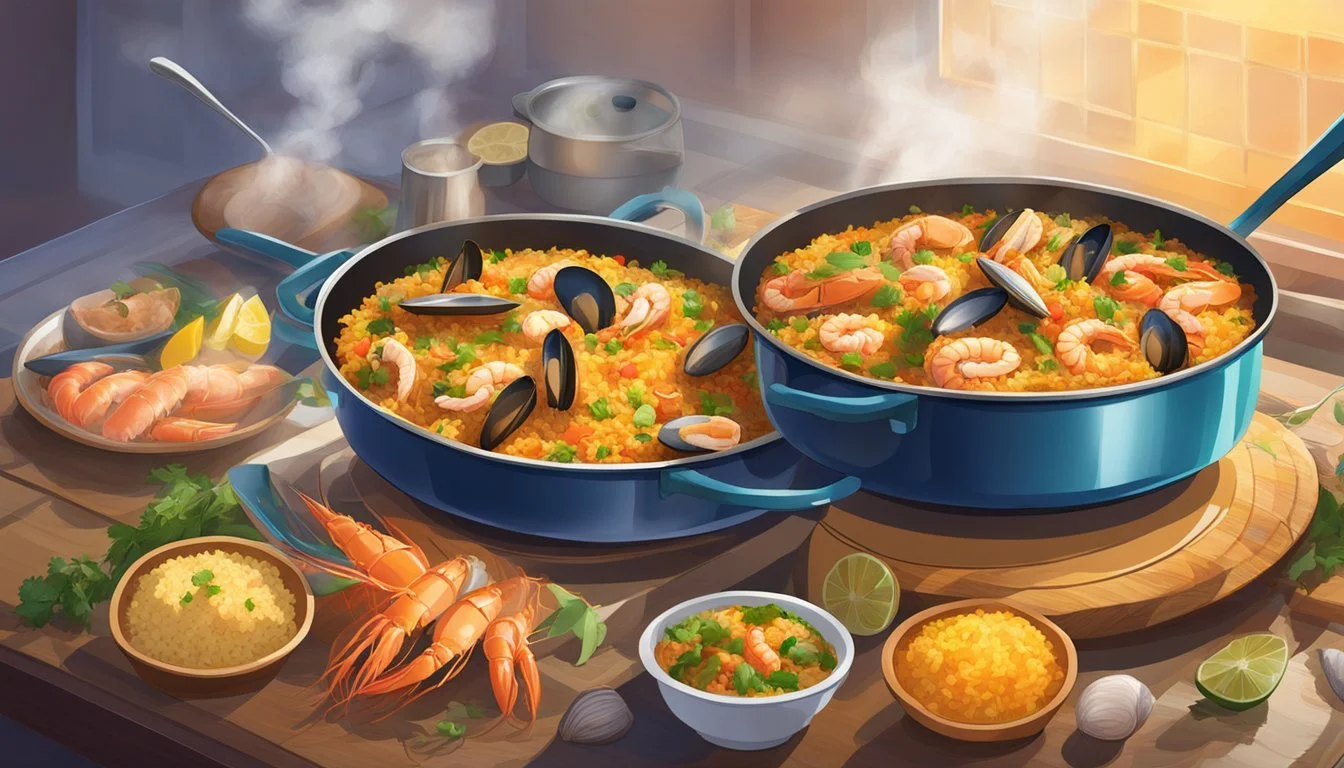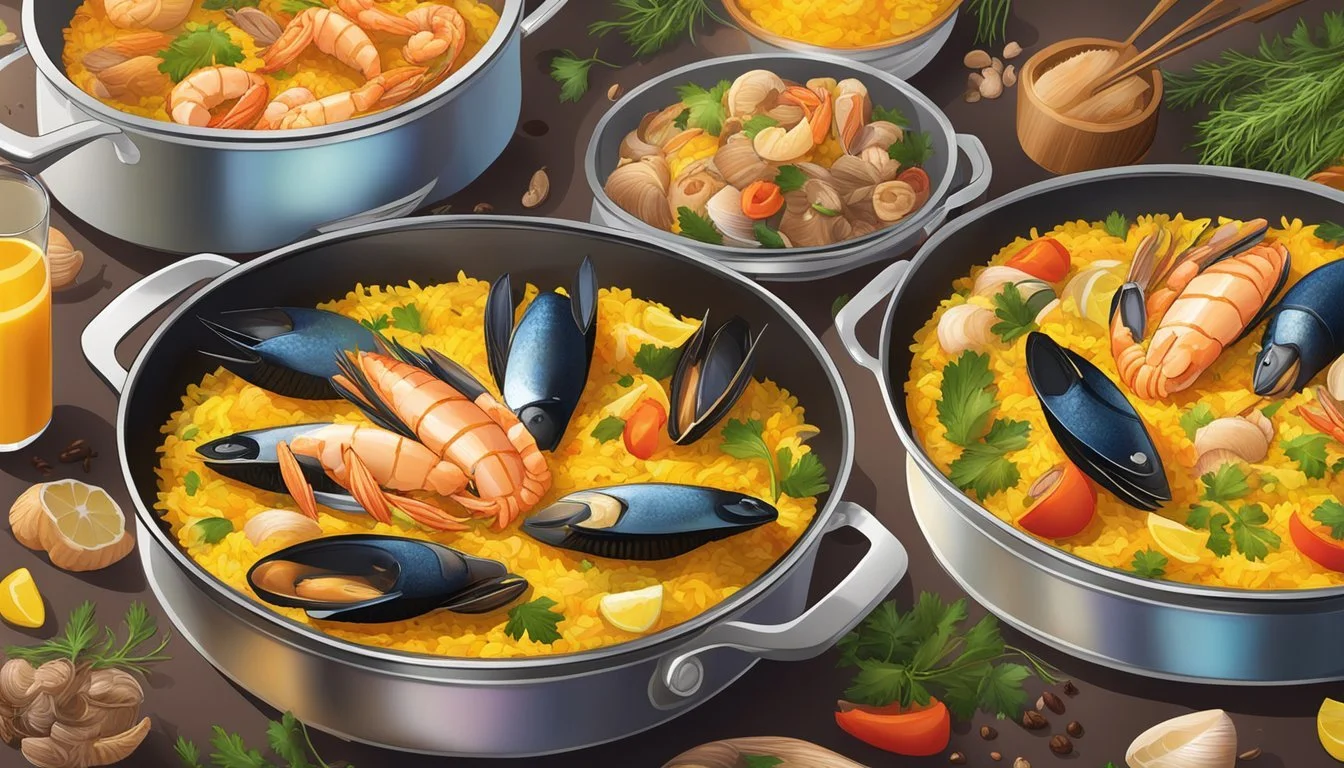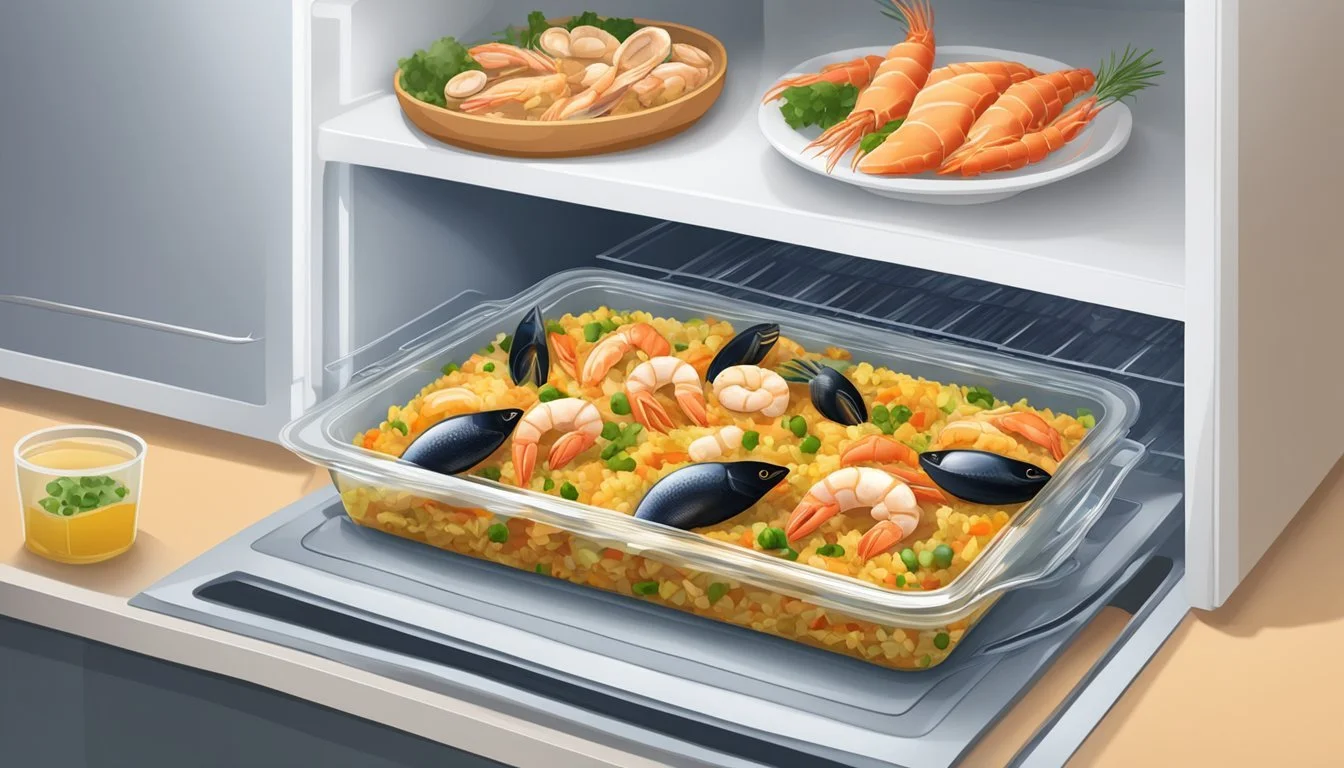Best Way to Reheat a Seafood Paella
Ensuring Tender Shellfish Every Time
When it comes to reheating seafood (What wine goes well with seafood?) paella, the main challenge lies in warming the dish thoroughly without overcooking the delicate shellfish. Seafood paella, a traditional Spanish dish brimming with rich flavors and a variety of textures, requires deft handling during reheating to maintain its integrity. The key is to apply gentle heat and retain moisture, as these elements are crucial for preserving the seafood's succulence and preventing the rice from drying out.
The best way to reheat seafood paella involves using methods that reinvigorate its taste and texture without compromising the quality of its ingredients. A common approach is on the stovetop, where controlled heat and the addition of liquid such as stock or water help to evenly warm the dish. In this method, a heavy-bottomed pan aids in distributing heat gently, and a lid is essential to trap steam, ensuring the rice becomes moist and the seafood heats without becoming rubbery. Alternatively, the oven can serve as a suitable method for larger portions, with added water to keep the rice from drying and a careful eye to avoid overcooking the seafood.
Achieving the perfect balance of reheating a seafood paella means respecting the ingredients and understanding how they interact with heat. Techniques that involve gradual warming and minor adjustments in temperature and hydration can help assure that the essence of the paella, especially its coveted seafood, remains as delightful as when it was first cooked. By focusing on these aspects, one can enjoy the savory delight of a properly reheated seafood paella with all its original flavors and textures.
Understanding Paella and Its Ingredients
The proper preparation of Paella hinges on the delicate balance and quality of its ingredients, with particular attention paid to the freshness of the seafood and the distinctive texture of the rice.
Key Components and Variety of Paella
Paella originates from Valencia, a region in Spain known for its rich culinary heritage. At its core, Paella is a versatile and communal Spanish rice dish typically prepared in a large, shallow pan. There are several variations of Paella, but they all share a few key components:
Rice: The foundation of any Paella is short-grain rice, often specifically Valencia or Bomba rice, which is known for its ability to absorb liquid while remaining firm.
Olive Oil: A generous amount of olive oil is used to sauté the ingredients, providing a distinct Mediterranean flavor.
Proteins: Traditional Paella may include a variety of meats like chicken and chorizo. Seafood Paella specifically emphasizes oceanic fare such as shrimp, clams (What wine goes well with clams?), mussels, (What wine goes well with mussels?) and sometimes squid or cuttlefish.
Vegetables: Aromatic vegetables like bell peppers, tomatoes, garlic, and sometimes beans, contribute to the layered flavors of the dish.
Seasonings: Saffron and paprika are the quintessential seasonings that offer Paella its iconic color and taste.
The cooking process and added ingredients can vary, from mixed Paellas that include both meat and seafood, to others focusing on a single protein source.
Importance of Seafood Quality and Freshness
The quality and freshness of the seafood used in Paella are paramount. As seafood can easily become overcooked and rubbery, it demands careful timing and respect to preserve its delicate texture and flavor:
Freshness: Using fresh, high-quality seafood not only enhances the dish's flavor but also its overall presentation.
Variety: A traditional seafood Paella incorporates a range of shellfish and sometimes fish, selected based on availability and region.
Preparation: The seafood is often one of the last ingredients added to the Paella, ensuring it cooks just enough without becoming tough.
Seasoning: Light seasoning of the seafood helps to elevate its natural flavors without overpowering them.
Understanding the role each ingredient plays in Paella helps one appreciate the subtleties of this dish and underscores the importance of not overcooking the seafood when reheating.
Storing Paella Correctly Before Reheating
Proper storage is critical for maintaining the quality of leftover paella and ensuring its safety for reheating. Not only does it preserve the dish’s flavors and textures, but it also minimizes the risk of food poisoning.
Airtight Containers and Refrigeration
Storing Cooked Paella:
Container: Transfer the leftover paella into an airtight container to prevent exposure to air and moisture.
Fridge Temperature: Keep the refrigerator at or below 40°F (4°C) to slow down bacterial growth.
Timing: Store paella within 24 hours of cooking to ensure freshness.
Shelf Life: Refrigerated paella should ideally be consumed within one week to maintain quality and safety.
Freezing Paella for Longer Shelf Life
Freezing and Thawing Paella:
Portion Size: Divide large batches of paella into portion-sized servings before freezing. This allows for easier defrosting and prevents waste.
Freezing: Use quality plastic or freezer-safe containers to freeze paella. Ensure they are sealed well to avoid freezer burn.
Defrost: Thaw frozen paella in the refrigerator overnight rather than at room temperature to reduce the risk of bacteria developing.
Duration: Properly frozen paella can be stored for up to four weeks. Beyond this, quality may start to diminish.
Reheating Methods for Optimal Quality
When reheating paella, maintaining the delicate texture of the seafood and rice is paramount. The following methods are tailored to ensure your leftover seafood paella regains its original splendor without overcooking the shellfish.
Oven Reheating Technique
To reheat paella in the oven while preserving moisture:
Preheat your oven to 350℉ (177℃).
Place paella in an oven-safe dish and sprinkle with a half cup of water to prevent drying.
Cover the dish with foil and heat for 20-25 minutes. This method facilitates even heat distribution and prevents the rice from becoming crispy.
Stovetop Method for Preserving Texture
For a stovetop approach that closely monitors the dish's texture:
Add a small amount of olive oil to a frying pan and heat over medium-low.
Transfer the seafood paella to the pan, gently stirring to encourage even heating.
Cover with a lid and steam for a few minutes, which adequately warms the shellfish without overcooking.
Microwave as a Quick Option
When time is of the essence, the microwave can be used to reheat paella:
Place the paella in a microwave-safe container and lightly coat the surface with oil.
Distribute the paella evenly to avoid cold spots and heat in one-minute intervals, checking to ensure an even temperature throughout.
Tips to Prevent Overcooking and Preserve Flavor
Properly reheating seafood paella is essential to maintain the dish's original texture and flavor. The goal is to avoid rubbery shellfish and dry rice while enhancing the meal's overall freshness.
Adding Moisture During Reheating
For seafood paella, moisture is the key element that prevents the rice and seafood from drying out. Adding a small amount of broth or water before reheating can create steam, which helps in retaining moisture. A ceramic or glass container works best for this purpose:
Lightly drizzle one to two tablespoons of broth over the paella, ensuring the liquid is evenly distributed.
Cover the container with foil or a suitable lid to trap the steam.
Adjusting Temperature and Time
The temperature and duration of reheating are critical components:
Preheat the oven to 350°F.
Place the covered paella in the oven for approximately 8 minutes.
It's important to heat just until the shrimp and other shellfish are warm to touch but not hot, to prevent them from becoming rubbery.
Finishing Touches Before Serving
Once the paella is thoroughly reheated, the final touches can enhance its appeal:
Stir the paella carefully to distribute the added moisture evenly.
Add a few drops of lemon juice or a fresh garnish to revive the flavors.
Serve promptly to your guests, ensuring the paella retains its heat and freshness.
Remember to ensure the paella is reheated to a safe temperature to avoid any risk of foodborne illness.
Potential Challenges and Solutions
When reheating seafood paella, one must navigate the tightrope between achieving optimal temperature and texture without compromising the dish’s integrity. The process presents distinct challenges, particularly concerning stickiness, uneven heating, and food safety.
Dealing with Stickiness and Uneven Heating
The nature of rice in paella can lead to issues with stickiness, especially when reheated improperly. Reheating should be done gently to distribute heat without drying out the rice or making it too sticky.
On the Stovetop:
Use a non-stick pan and add a small amount of olive oil or broth.
Heat on medium-low to prevent the rice from sticking to the pan.
In the Microwave:
Place the paella in a microwave-safe container.
Add a tiny amount of oil to avoid stickiness.
Reheat in short intervals, stirring between each to promote even heating.
Ensuring Safety and Avoiding Food Poisoning
The safety of leftovers, particularly seafood and meats, is crucial, as they can harbor bacteria if not stored and reheated correctly. The goal is to reheat paella to a safe internal temperature without overcooking delicate seafood.
Temperature Guidelines: Ensure reheating to an internal temperature of at least 165°F (74°C) to prevent food poisoning.
Storage Tips:
Cool down leftovers quickly to room temperature and refrigerate within two hours to minimize bacterial growth.
Store in a sealed container to keep the paella safe and prevent contamination.
By following these recommendations, one can skillfully reheat seafood paella, retaining its flavors and textures while ensuring it is safe to enjoy.
Conclusion
When reheating seafood paella, the goal is to maintain the dish's moistness and prevent the overcooking of delicate shellfish. A stovetop method with a heavy-bottomed pan and a small addition of stock can achieve this balance, warming the paella gently while preserving its flavors. A tight-fitting lid is crucial for retaining steam and moisture.
Alternatively, using an oven preheated to 350℉ with water added to the paella is also effective. It provides even heating and maintains the dish's traditional texture and taste. However, caution is advised to ensure that no component, especially shellfish, is subjected to excessive heat.
For those preferring the microwave, heating in intervals with a cover and adding a small amount of oil can distribute warmth evenly. This method is ideal for serving the paella quickly, maintaining the needed moisture without sogginess.
Regardless of whether it's seafood, chicken, or vegetable paella, uniform reheating is essential. Users must avoid high heat and rush, which can adversely affect texture and taste. By following these methods, one can ensure that the reheated paella remains as enjoyable as when it was first prepared, with shellfish tender and flavors robust.




